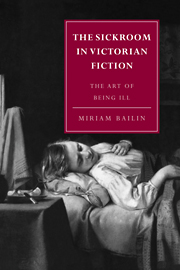3 - Charles Dickens: “impossible existences”
Published online by Cambridge University Press: 24 October 2009
Summary
“Wishin' you lots of sickness ” (MC 29), Sairey Gamp's parting salute to her colleague, Betsey Prig, has a wider application and significance in Dickens's fiction as a whole than its immediate comic context would suggest. There is “lots of sickness ” in his novels, and the profits to be gained by it are neither solely nor primarily confined to those for whom it provides a ready source of income. Sairey's mercenary reversal of the usual parting expectations of good health, however rich a source of humor, corresponds to the consistent reversal of illness from curse to blessing in the lives of most of the major and many of the minor characters who inhabit the Dickens world. Illness in Dickens's fiction is the sine qua non both of restored or reconstructed identity, and of narrative structure and closure.
Dickensian patients, like their counterparts in other Victorian fiction, move from the extremities of personal crisis in “the fevered world” to the protective sequestration of the “fevered room” (LD ii, 33) where a loving nurse or sequence of nurses stands by with soothing remedies at hand and where the barriers between hitherto estranged loved ones, or between aspects of their own divided selves, collapse under the leveling power of physical distress. In just such a manner is Eugene Wrayburn united with Lizzie Hexam, Arthur Clenham with Little Dorrit, Dick Swiveller with the Marchioness, and Oliver Twist with, first, Mr. Brownlow, then the Maylies. It is thus that Pip is reconciled with Joe, Esther Summerson with Lady Dedlock, Martin Chuzzlewit with Mark Tapley, and, of course, all of them with themselves.
- Type
- Chapter
- Information
- The Sickroom in Victorian FictionThe Art of Being Ill, pp. 79 - 108Publisher: Cambridge University PressPrint publication year: 1994



